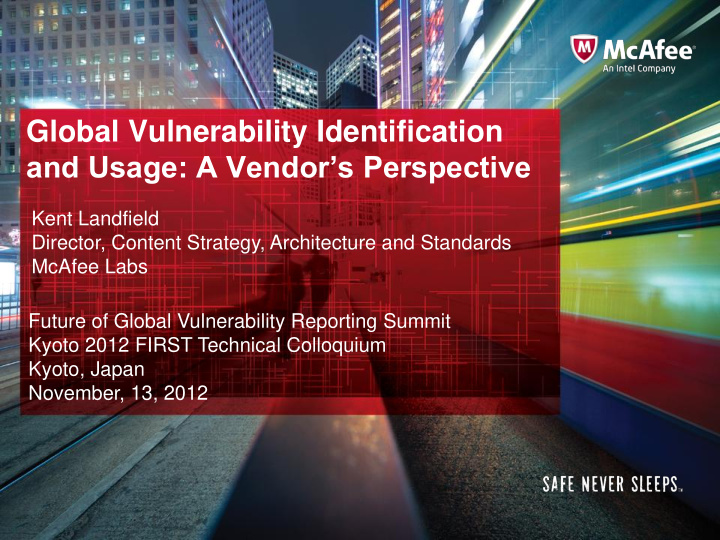



Global Vulnerability Identification and Usage: A Vendor’s Perspective Kent Landfield Director, Content Strategy, Architecture and Standards McAfee Labs Future of Global Vulnerability Reporting Summit Kyoto 2012 FIRST Technical Colloquium Kyoto, Japan November, 13, 2012
Agenda • Vendor Vulnerability Identification Uses • Industry Vulnerability Identification Uses • McAfee CVE Usage • Current Problems with the Existing Vulnerability Landscape • CVE Format Issues • So what is really needed and why are we here?
Vendor Vulnerability Identification Usage • Vulnerability Management Technologies – Detecting vulnerabilities in the deployed environment – Patching / remediating vulnerabilities – Reporting security posture status for organizational uses • Vendor security related bulletins – Publishing – Compliance • Information Key for security related databases – Research – Reporting 3 November 27, 2012
Industry Vulnerability Identification Usage • Information Sharing between organizations or departments – Incident Handling – Operational security posture tracking – Security investment success • Tracking method for use in determining the trending and scope of vulnerabilities – Costing – Awareness of the problem • Common means to indicate that a single software vulnerability is a single condition – Unidentified vulnerabilities can appear as multiple problems when reported by multiple vendors 4 November 27, 2012
McAfee CVE Usage • Customer Focused – Usage in our commercial products to assure the user’s have an understanding of what is in or not in their environments – Correlation of information for informing, displaying and reporting on vulnerability related issues • Security Research – Extensive use as a primary key within our Compliance, Vulnerability, malware/malicious code and Global Threat Intelligence research environments – Common identifier that relates information between the teams – Metric for our coverage percentages for the individual products • Common “language” for communicating vulnerabilities with our cooperating partners, Symantec, Trend, Cisco, HP, Microsoft and many, many others… • And we are finding more uses on a very consistent basis… 5 November 27, 2012
Current Problems with the Existing Vulnerability Landscape • Blind, Deaf and Dumb – CVE has been the foundational means for vulnerability identification • English speaking for the most part – Regional uses for vulnerability identification masks the problem – National / Regional means for identifying are lacking • Some are established and correlated with CVE • Some are immature in their process development • Some don’t exist at all – For the most part…. software vendors have been totally focused on CVE as the sole means for vulnerability identification – Large software development markets have no real established vulnerability identification programs that are visible to vendors and the regional community they were written for – Vendors can’t assist checking or correlating vulnerabilities they do not know about 6 November 27, 2012
CVE Format Issues • Existing CVE format too small for English speaking vulnerability reporting today • Limited to 10,000 vulnerabilities in a single year – CVE-YYYY-NNNN • We have already exceeded that in the last couple years – Internal research data • Do we simply add two digits to make it a 1,000,000 in a single year ? – CVE-YYYY-NNNNNN – Will that be enough for future uses ? • We really need to keep it simple. What does that mean? • What is the impact of format change on existing CVE support ?
So what is really needed and why are we here? • The world is getting smaller by the year as the global network expands • Security and network operations professionals / management need to be able to identify all vulnerabilities in their environment, regardless of what part of the world the software was written in. • Vendors need a means to supply customers with the ability to determine a network’s true vulnerability posture • Security Research organizations need to know the complete landscape and not simply a portion of it • CERTs and other Incident Handling organizations need to be able to deal with global issues consistently and effectively • Need to extend CVE regardless as we are reaching the limits of the established CVE format • Can we attack / solve two problems with one solution ?
Recommend
More recommend